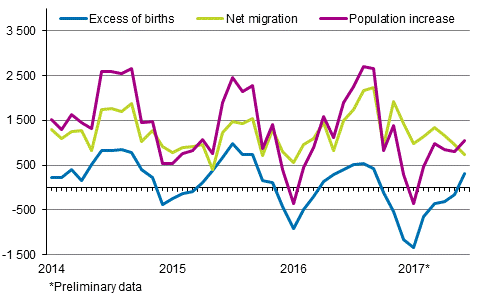Published: 25 July 2017
Finland’s preliminary population figure 5,507,101 at the end of June
New releases will not be produced on preliminary population statistics any more in 2017. Revised figures concerning 2017 will be released at a later date to be announced separately.
According to Statistics Finland's preliminary data, Finland's population at the end of June was 5,507,101. During January-June Finland's population increased by 3,804 persons, which is 1,805 persons less than in the preliminary data the year before. The reason for the population increase was migration gain from abroad: the number of immigrants was 6,324 higher than that of emigrants. There was no natural population growth, since deaths exceeded births by 2,520 persons.
Population increase by month 2014–2017*

According to the preliminary statistics for January-June 2017, a total of 24,937 children were born, which is 1,693 fewer than in the corresponding period 2016. The number of deaths was 27,457, which is 44 higher than one year earlier.
Altogether 12,772 persons immigrated to Finland from abroad and 6,448 persons emigrated from Finland during January-June period. The number of immigrants was 1,493 lower and the number of emigrants 1,425 lower than in the previous year. In all, 3,531 of the immigrants and 4,220 of the emigrants were Finnish citizens.
According to the preliminary data, the number of inter-municipal migrations totalled 128,320 by the end of June. Compared with the previous year, the increase was 3,960 migrations according to the municipal division of 2017.
Same-sex marriages took legal effect in March 2017. A total of 148 women and 73 men entered into marriage in which the spouse was of the same sex during March-June period. In all, 1,279 women and 674 men changed their registered partnership into marriage.
According to preliminary data by region, the population grew only in Uusimaa, Varsinais-Suomi, Pirkanmaa, North Ostrobothnia, Central Ostrobothnia and Åland in the early part of 2017.
The population grew most in absolute numbers in Uusimaa, where it grew by 10,406 persons. The next largest increase in population was seen in Varsinais-Suomi, 699 persons. Relative to the population, population increase was highest in Åland, 8.4 per mil, in Uusimaa, 6.4 per mil and in Varsinais-Suomi, 1.5 per mil. Population loss was highest in absolute numbers in the region of Lapland that lost 1,089 persons of its population. The population of Kymenlaakso decreased by 904 persons. Relative to the population, the biggest population loss was also found in Lapland, 6 per mil.
Most migration gain from intramunicipal and international migration was collected by Uusimaa, 8,335 persons and Varsinais-Suomi, 1,127 persons. Most migration gain in relative terms based on total net migration was attained by Åland, 6.7 per mil and Uusimaa, 5.1 per mil.
In absolute numbers, migration loss from total net migration was biggest in the region of Lapland, 728 persons. In the region of Ostrobothnia the loss was 682 persons. In relative terms, the biggest migration loss from total net migration was found in the region of Lapland, 4 per mil of the population.
During the first half of 2017, migration between regions numbered 58,834, which was 2,685 moves greater than in the previous year. The positive gain from migration between regions was seen in Uusimaa, Varsinais-Suomi, Pirkanmaa and Åland. In absolute numbers, the highest gain from migration between regions was received by Uusimaa, 5,841 persons. The relative migration gain was also highest in Uusimaa, 3.6 per mil of the population.
Migration loss from migration between regions was biggest in absolute numbers in the region of Ostrobothnia, 1,128 persons. Migration loss from migration between regions was also biggest in relative terms in the region of Ostrobothnia, 6.2 per mil of the population.
Source: Preliminary population statistics, Statistics Finland
Inquiries: Matti Saari 029 551 3401, Joonas Toivola 029 551 3355, info@stat.fi
Director in charge: Jari Tarkoma
Publication in pdf-format (287.8 kB)
- Tables
-
Tables in databases
Pick the data you need into tables, view the data as graphs, or download the data for your use.
Appendix tables
- Appendix table 1. Preliminary data on vital statistics by month of occurence 2017 (25.7.2017)
- Appendix table 2. Vital statistics, final data 2010 - 2016 and preliminary data 2017* (25.7.2017)
- Appendix table 3. Comparison between preliminary vital statistics in 2017 and 2016 (25.7.2017)
- Appendix table 4. Preliminary vital statistics by region 2017 and change compared to 2016 final data, quarters 1 - 2 (The heading was corrected on 26 October 2017) (25.7.2017)
- Appendix table 5. Preliminary data by region on immigrants and emigrants according to country of departure/destination 2017, quarters 1 - 2 (The heading was corrected on 26 October 2017) (25.7.2017)
- Figures
-
- Appendix figure 1. Live births by quarter 1995 - 2016 and preliminary data 2017 (The heading was corrected on 26 October 2017) (25.7.2017)
- Appendix figure 2. Deaths by quarter 1995 - 2016 and preliminary data 2017 (The heading was corrected on 26 October 2017) (25.7.2017)
- Appendix figure 3. Intermunicipal migration by quarter 1995 - 2016 and preliminary data 2017 (The heading was corrected on 26 October 2017) (25.7.2017)
- Appendix figure 4. Immigration by quarter 1995 - 2016 and preliminary data 2017 (The heading was corrected on 26 October 2017) (25.7.2017)
- Appendix figure 5. Emigration by quarter 1995 - 2016 and preliminary data 2017 (The heading was corrected on 26 October 2017) (25.7.2017)
Updated 25.7.2017
Official Statistics of Finland (OSF):
Preliminary population statistics [e-publication].
ISSN=2243-3627. June 2017. Helsinki: Statistics Finland [referred: 21.12.2025].
Access method: http://stat.fi/til/vamuu/2017/06/vamuu_2017_06_2017-07-25_tie_001_en.html

